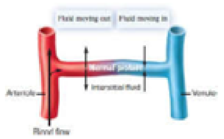
Core Skill: Modeling The goal of this modeling challenge is to make a model that depicts the relative movement of fluid between a capillary and the interstitial fluid when the amount of protein in an animal's blood is abnormally low.

Model of fluid movement into and out of a capillary
Modeling Challenge: In the simplified model of fluid movement between a capillary and interstitial fluid on the right, two sets of arrows are used to indicate the net movement of fluid at two places along a capillary: near the arteriole and near the venule. The length of an arrow represents the relative amount of fluid moving from one compartment to the other. Let’s assume that the protein concentration of the blood becomes lower than normal (this could happen, for example, in a malnourished animal). Draw a model like the one given with arrows showing the relative fluid movements at the arterial and venule ends of the capillary under these new conditions. Remember to use the length of an arrow to indicate the relative amount of fluid movement; a longer arrow represents a greater amount of fluid moving into or out of the capillary.
Want to see the full answer?
Check out a sample textbook solution
Chapter 53 Solutions
Biology
- Exercise 12.21. A hospital has identified nonrandom variations in patient falls. Draw a flow chart showing under what circumstances a patient might fall. Construct a cause-and-effect diagram showing the potential causes of falls. Develop a Pareto diagram to prioritize the causes of falls for planning to solve the problem.arrow_forwardbiomedical instrumentation question: Design a ventilator using block representation. (Draw detailed block diagrams, express the necessary valves, sensors and electronic components.)arrow_forwardUsing knee angular position and thigh angular position what graph could be developed? a phase plane portrait an angle-angle diagram a center of pressure record a rectified EMG record none of the abovearrow_forward
- Q41: Regarding jellyfish swimming, the recovery stroke of the jellyfish swimmimg mechanism, the medusa is returned to its resting state byarrow_forwardOrder: 1500 mL D5NS IV to run over 12 hoursCalculate the drops per minute (gtts/min) for each of the different tubing.a) ML/hr b) Macro drop (10 gtt/mL) c) Micro drip (60 gtt/mL) Order: dobutamine (Dobutrex) 57mcg/kg/minute IVPatient: 70 lbSupply 500mg/250 mL D5W Solve for ml/hr.arrow_forwardFlow (L/min) 80- 60- 40- 20- O --20- -40- -60- Tano Volume (mL) 100 200 300 400 500 B F-V loop (see Review Question 6). a. What is the target variable in this figure? b. What is the flow setting and flow waveform? c. What is the VT delivery? LULarrow_forward
- Order: IV 1/2 NS 100 mL/hr for 8 hours. Calculate rate using macro-drip tubing (20 gtts/mL): gtts/minarrow_forwardList the steps involved in a good systematic approach to ECG analysis?arrow_forwardExercise No. 7 1. Give the normal differential count of the different blood cells seen. 2. Briefly define the following: a. Crenation b. Hemolysis - c. Rouleaux formation - Exercise No. 8 1. Differentiate the three (3) types of muscles; tabulated form. 2. Define the sarcoplasmic triad. Where can it be found? 3. What is an intercalated disc? Exercise No. 9 1. What are neuroglial cells? 2. Differentiate axon and dendrite. 3. What are other nerve endings?arrow_forward
- The effect of length on flow rate The effect of length on flow rate. A: the fluid reservoir is placed on top of the bench (Figure 2A) to give a pressure head. This is connected to the flow module by rubber tubing with a clamp on it. A 5-mL volumetric flask is used to collect fluid, and the time taken with different lengths of tubes is recorded on a stopwatch. (Figure 2B) The calculated flow rate plotted against the length of tube. Interpret the graph/data Would you expect the length of blood vessels to change in the body as a means of controlling flow? Comment on your answer. Is this likely to be a common mechanism for controlling blood flow to different tissues?arrow_forward6. Calculate Oxytocin order: The provider orders oxytocin 30 units in 500ml LR to infuse at 2mu/min. How much would you administer in ml/hr? Bring your calculation to your on-campus simulation. Ainsidiarrow_forwardQ14) The pressure in the spinal fluid in the body is measured in the manner shown in the figure below. If the pressure of the spinal fluid is a), (10 mmHg), what is the reading of the water pressure gauge in the unit (crm water) if the person's position is horizontal (b) what is the reading To scale if the person stands, place the top of the liquid 60cm above the X. Note that the density of spinal fluid is 1.05 g/ml, water is g/ml 1.0, lily is 13.5 g/ml, and the acceleration is 9.81 m/s2. P=10 mm Hg ? cm H20 (a) 13.6cm (b) 76.6cm (a) 1.36cm (b) 7.66cm O (a) 1.36cm O(a) 1.36cm (b) 76.6cm O(a) 13.6cm (b) 7.66cmarrow_forward
- Lifetime Physical Fitness & WellnessHealth & NutritionISBN:9781337677509Author:HOEGERPublisher:Cengage


